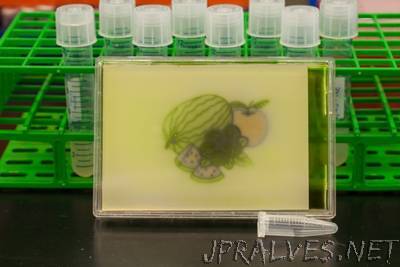
“MIT researchers have engineered bacteria with “multicolor vision” — E. coli that recognize red, green, or blue (RGB) light and, in response to each color, express different genes that perform different biological functions. To showcase the technology, the researchers produced several colored images on culture plates — one of which spells out “MIT” — by using RGB lights to control the pigment produced by the bacteria. Outside of the lab, the technology could also prove useful for commercial, pharmaceutical, and other applications. The E. coli is programmed with a protein- and enzyme-based system, analogous to a computer chip, with several different modules to process the light input and produce a biological output. In computing terms, a “sensor array” first becomes activated in the presence of either red, green, or blue light, and a “circuit” processes the signal. Then, a “resource allocator” connects the processed information to “actuators” that implement the corresponding biological function. Think of the new E. coli as microbial marionettes, with colored light instead of puppet strings making the bacteria act in a certain way, says MIT professor of biological engineering Chris Voigt, co-author of a paper in Nature describing the technology. “Using different colors, we can control different genes that are being expressed,” he says. The paper’s co-authors are former postdocs Jesus Fernandez-Rodriguez, Felix Moser, and Miryoung Song.”
